Growing orchids on trees is an exotic way to showcase your orchids year-round. If you live in a hardiness zone that permits growing orchids outside, (generally USDA Zone 11, which includes: Florida, Hawaii, the Caribbean and southern California) then you definitely will want to try this method. It’s where orchids grow naturally.
If you don’t live in a zone that provides the environment to properly acclimate orchids outside (you can check the hardiness zone on this website ) don’t despair. We’ll teach you how to mount them on tree bark and hang them inside in another article.
) don’t despair. We’ll teach you how to mount them on tree bark and hang them inside in another article.
Steps to Mounting Orchids on Trees
- Find the right Tree
- Locate the fixation place for the Orchid
- Choose an Appropriate Orchid
- Gather Material: moss and Cotton Ties
- Place your Orchid on the Mount and Tie
What benefits does the orchid get from the tree?
Being attached to a tree, your orchid will already have the light/shade requirements that it needs without supplemental lighting. If you are mounting an orchid on a wall mount, you’ll probably nee artificial light. You can read more about indoor lighting here.
The rain is free of chemicals that city reservoirs add to treat consumption water, like chlorine. You won’t have to used distilled water or let your water soak for 24 hours before watering.
The temperature of the water is perfect, not being too hot, and certainly not cold, like ice cubes.
Rain quickly drenches the orchid, and freely runs down the rest of the tree, not allowing for root rot. Drainage, drainage, drainage…
Image Credit: “Branch orchids” by Greg Lee is licensed under CC BY 2.0 . With adequate wind circulation, it’s hard for fungus and bacteria to accumulate in the crown of the orchid.
With adequate wind circulation, it’s hard for fungus and bacteria to accumulate in the crown of the orchid.
Wind will also favor pollinators, which is one of the orchid’s main functions.Being high up in the nook of a tree, an orchid is free from ground dwellers who munch on the leaves. They also are less likely to be infested with pests and insects, compared to dwelling on the ground.
Orchids don’t get their nutrients from the tree, so they aren’t parasitic. It won’t hurt a tree trunk to attach an orchid to it. Nothing is being robbed from the tree, in aid of the orchid. The only reason orchids attach themselves to tree trunks is to firmly hold on.
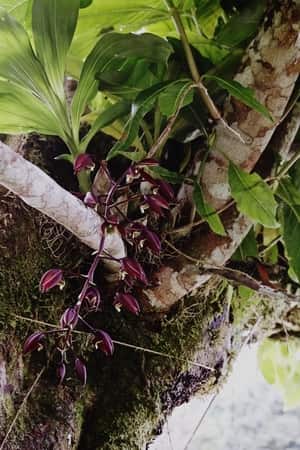
Choosing the Right Tree for Your Orchid
Before you choose an orchid to mount, you need to find the perfect tree to mount it on. The overhead canopy needs to let some sunlight through, so don’t pick a spot on the tree that is 100% in the shade.
The bark needs to be rougher, with craggy nicks and uneven crannies, so the roots have something to attach to. Smooth bark doesn’t offer the enough difference in texture that the roots need.
Avoid trees where the bark will chip off in hunks. It’s easy for the orchid to completely break off the tree during a hard rain.
Good candidates for this are: oaks, palm, avocado, citrus, schefflera and any tree that has jagged, coarse bark.
Once you have chosen the perfect tree, find the best spot for your orchid. Make sure to observe the darker side of the tree, since no orchid like to be in the sun all day long.
Also, the darker side is usually where water trickles down the bark when it rains. If you attach the orchid to the driest side of the tree, the roots will dry out.
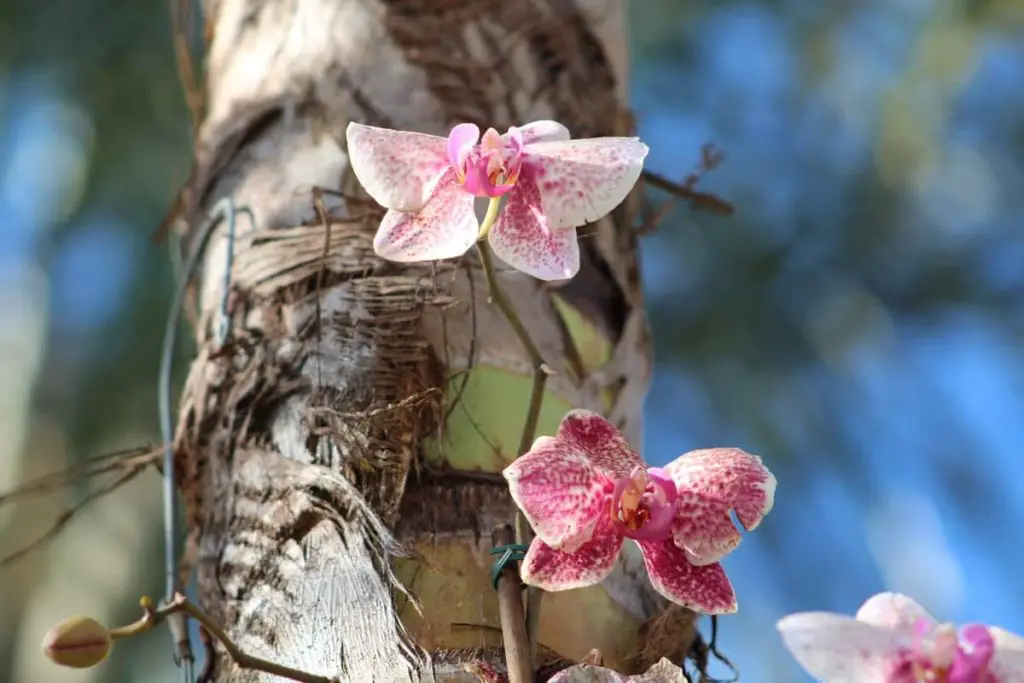
A good idea is to search for lichen.
Moss on tress signify that the airflow (and quality) is ideal and the sun isn’t too hot or direct.Verify to see how cold the northern winds are in your area, and if your orchid can tolerate them. Even if they do, don’t attach the orchid to the north side—if possible.
If you can, and all the items listed before match up, attach your orchid in the south-facing position. This gives the leaves adequate sun and bright light, without exposing your orchid to much direct sunlight or cold wind.
If the tree branches off, take a look at where the bifurcations occurs. If there is a crevice that accumulates water, then this isn’t going to be ideal.
Find crevices or nooks that can drain properly.
Choosing the Right Orchid for Your Tree
The second part of mounting an orchid in trees is choosing the right orchid. Not all orchids will live well in your climate, or adapt well to your temperatures outside.
Do your research to see if your orchid is a cooler climate or enjoys hotter temperatures. Does your orchid like sun or prefer shade?
High-light orchids are Vandas, some kinds of Cattleyas, and Dendrobiums. Orchids that prefer bright shade, or medium light, are: Miltonias and the majority of Cattleyas. Orchids that prefer bright light but totally in the shade are the Phalaenopsis, Oncidiums, and Paphiopedilums.
My suggestion would be to start with miniature Cattleyas (medium to high light) and Phalaenopsis (low-light), since these are some of the easiest orchid to grow.
If you have success, then try a Brassavola with a larger mount.
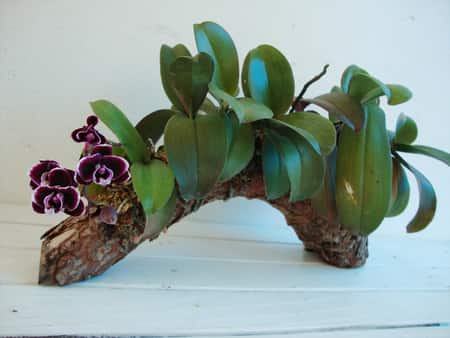
by o0o Dylan o0o is licensed under CC BY-SA 2.0

Whatever orchid you choose, make sure it is drought resistant, since orchids outside will dry out faster. Wall-mounted orchids will dry out faster, too.
If your orchid thrives in a more humid climate, don’t try to attach it to a mount or a tree.
Once you match an orchid with light, humidity, and temperature preferences to your tree, then you’re set to go.
When is the Best Time to Attach the Orchid to A Tree?
Watch for new growth of roots. When an orchid has finished blossoming, and all the buds have fallen off, your orchid might go dormant. Some do, others don’t. After the dormancy period, which might be from a few weeks to a couple months, new roots start to appear.
This is the best time to attach the orchid to a tree, since the roots will be looking for firmness and sturdy bark. It’s harder to attach older roots that have already grown in potting medium to become accustomed to tree bark.
How do I attach the orchid to the tree?
1. Make a visual layout or preview before starting.
Spread the roots of the orchid outward, so none are overlapping each other. Arrange them on the tree bark as if they are giving the tree a small hug. The roots need to spread out, like a clock in all directions.
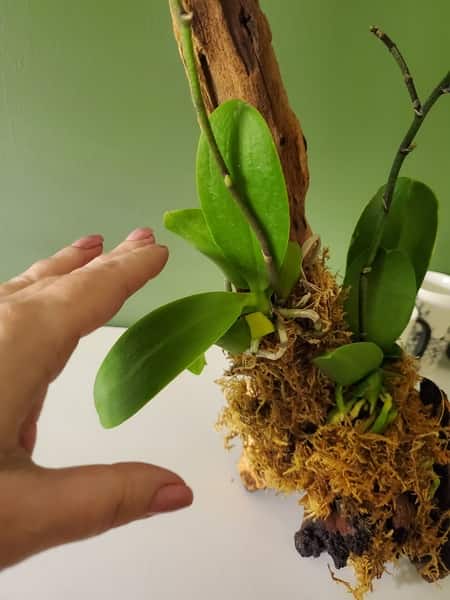
2. Don’t use any type of potting mix now.
The temptation will be to make a “chair” or “pillow” for the orchid, but resist this idea. The orchid needs to be directly in touch with the bark. Many new orchid growers attach sphagnum moss as an in between layer, but it doesn’t provide any advantages.
In fact, this layer in-between the roots will only rot quickly.As for the plant, make sure you are holding it the right way, which would probably mean “sideways.” If it rains, will water be collected in the crown of the plant?
Phalaenopsis orchids grow naturally “sideways,” which to us, seems like it’s the wrong way. This isn’t how they are normally displayed in supermarkets and grocery stores. The main reason for this is so the rain will drain properly from the plant and not accumulate.
When attaching orchids in trees, make sure you are attaching them the way they’d grow in nature.
3. With cotton string, loosely wrap the orchid onto the tree.
Avoid the urge to securely fasten it, squeezing all the juice and life of its roots. If the orchid doesn’t wobble with the wind, or move when tugged on, then it is firmly attached.
If you wrap the cotton string too tight, you risk looking the roots and harming the stem. Wrap a couple times around the tree, making sure the orchid is attached.
In time, the cotton string will disintegrate into the environment. This might take one or two years, but by then, your orchid will have successfully attached to the bark and don’t need extra support.
If you’d like, you can use other material to securely fasten your orchid to the bark. Plastic ties or eve hot glue guns, but we don’t recommend them as much.
4. Now is the time to add sphagnum moss.
Cover the roots with moss until they are well packed. This is important for the first few months for orchids in trees, as the sphagnum will eventually fall off or decay. But the initial humidity is important, since the roots will be more exposed to wind than before.
The aim is for the moss to fall off, so don’t wrap it too tightly either.
Leave out a few aerial roots so the orchid gets its nutrients from the dust and wind. If they are buried in sphagnum, they won’t function properly.
Don’t Stop Learning!
If you want to be included in more information and get a 14-page fertilization guide, please sign up for my newsletter. I don’t spam, but send emails out bi-monthly with some curious topics of interest. If you want more information, click here to go to a specific page on this website where I explain it more in detail.

Also, if you are looking for an orchid journal to keep your notes specifically about orchid care, check out my 2 solutions for that on this page. If note-keeping isn’t your thing, then there is a free excel spreadsheet that you can download. Click here for more information on how to do that.
If you subscribe to my newsletter, I will send you a 14-page guide on the main tips of orchid fertilizer. It is downloadable and you can print it out on your computer. I designed the guide to double up as a coloring book, just to make it fun.
How do I care for an orchid attached to a tree?
During the first few months, your orchid will need additional care. Mist or spray your orchid daily, to ensure that the roots are getting adequate humidity and water.
Check often to see how the cotton ties are holding up and if the sun is directly shinning on the orchid leaves.
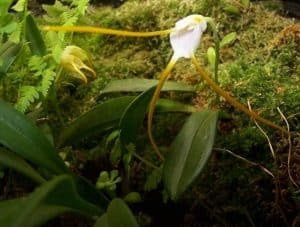
Looking for Inspiration?
If you need inspiration, this article in the Miami Herald talks about a social project that involved attaching orchids on trees around the city. The Million Orchid Project, done in 2013, was conceived to teach students about biology and botany.
talks about a social project that involved attaching orchids on trees around the city. The Million Orchid Project, done in 2013, was conceived to teach students about biology and botany.
With the help of the city, 750 orchids were donated and attached to trees, including “butterfly orchid (Encyclia tampensis), cowhorn orchid (Cyrtopodium punctatum), cockleshell orchid (Prosthechea cochleata), and night fragrant epidendrum (Epidendrum nocturnum).”
If you want more inspiration, take a look at my Pinterest Board , with images that I collect from viewers. The link takes you directly to the board about Orchids mounted on Trees, but there are tons of other boards on my Pinterest page
, with images that I collect from viewers. The link takes you directly to the board about Orchids mounted on Trees, but there are tons of other boards on my Pinterest page to inspire you.
to inspire you.
Now that you know all about mounting orchids in trees, what to look for when selecting a tree and the right orchid, and how to attach it, it’s time to get your hands dirty. LOL Check out some of our tutorials on how to design a great floral design or build a terrarium with orchids.
If this information was of any help, and clarified any doubts you had, please mention so in the comments. I love to interact with other orchid enthusiasts, and can share from our experiences.
Share this page with a friend who has an orchid, comment, or just give me a thumbs up 😊 in the comments below.
Happy cultivating!


Once the orchid is attached to the tree, do I need more moss or is it healthy for the roots and stems to be exposed to the air?
Hi Ellen,
Most orchids would be fine without the moss but it depends a lot on your climate. If your area is humid most of the day and very moist during early morning and late afternoon, your orchid should be fine. If you live in a drier climate, then you’ll need the extra moss and probably some morning misting, too. It all depends on how much humidity and rainfall your area gets.
-Amanda
When attaching an orchid to a tree, do you bind the roots to the tree or let them flow down from the plant un abated? The plant is secure, Im just not sure about the roots.
Hi Michael,
If the plant is secure and there are some roots in close proximity to the tree bark, I’d leave the others free-flowing. They like it that way. If there are no roots that are near the tree bark (all flying gin the air) and just the stem is attached, then you need to tie the roots so they will grow into the bark with time.
-Amanda
Thank you so much! I feel myself falling falling falling in to a rabbit hole of ……..orchids! Excellent article and so much info is shared! This is the week… my Orchids will begin their lives in my trees!
Hi Kim B,
My pleasure! I wish all your orchids a great move to their new home!
-Amanda
Thanks for the useful info, will plant my new orchids today
Hi Willie,
Thank you for leaving a comment! I appreciate it.
-Amanda
Looking for more information on attaching orchids to wood for indoor display. I live in CO and can’t plant outside but my tropical soul needs orchids! Our store bought orchids die quickly any advice or link to other articles would be of great assistance.
Hi Amanda just loved all the information on tree mounted orchids. I live in KZN South Africa. Very humid in the summer time. I have an orchid on a palm tree. Which has just started flowering. Would like to be included on your mailing list. Have a super day.
Kind regards
Avril
I bought a house that has orchids growing on the trees. However, they are looking very wild, a lot of roots and sparse leaves. Is there a good way to trim it down to promote leaf and stem growth?
I have double Orchidd do I need to cut them before I plant them in the tree.
They have not flower at all
I’m in an ideal orchid growing environment and just dropped into your article because I’m in the process of reattaching several orchids to a palm tree that have lived on there for several years. Extreme rain and wind loosened several bark supports. Then a nearby well established climbing vine sent multiple shoots and suckers, further entangling the orchids, some of which were well in bloom. I originally used stretchy green band-type undergirding but may reattach with a wide hole fencing like the type I used to keep rabbits from my hibiscus “tree”. The weight of the orchids, stems, leaves, and crowns is excessive, they are hanging by a few roots not close enough to the tree. They have shade but are not always visible behind a tall gardenia bush. I am not an orchid expert by any means but in the right climate (south Florida) orchids can become blue ribbon winners after they mature.